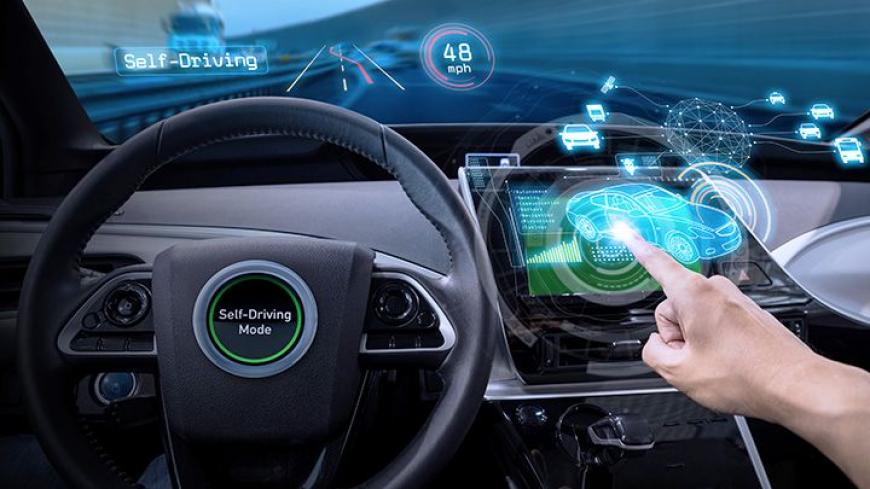Self-Driving Cars Are Almost Here, but Questions Remain

Ready or not, the driverless car era is upon us. And depending on whom you ask, some are more prepared than others to embrace automated vehicles.
Manufacturers—eager to establish themselves as top players in the emerging market—are investing billions of dollars in research and development and spending millions on government lobbying.
States, meanwhile, are rolling out competing autonomous vehicle regulations as they court technology companies and the cash cow potential driverless cars represent.
Disruptions from self-driving and flying cars will be widespread.
But while patchwork state regulations may be useful for finding out the best path forward in the driverless era, comprehensive federal regulations will likely be needed sooner rather than later to avoid state-to-state rule conflicts. At the same time, over-regulating the industry early on could dampen innovation right at the time growth is exploding.
Then there is the public, who, despite assurances that self-driving cars will vastly reduce accidents and lead to a brave new world of on-the-go leisure, expresses reservations about autonomous technology.
Public fear of the driverless car is not unfounded. Many have asked how automated vehicles should respond to the moral dilemma of whether it’s preferable to, say, run down pedestrians in a crosswalk or crash into a tree.
Whichever choice the car makes, it raises another question being hotly contested by lawyers and insurance brokers: who is responsible for the damages?
These are just a few of the issues that self-driving cars pose. As we move into the driverless era, numerous industries will be disrupted in a society that currently revolves around the personal, self-driven vehicle.
Self-driving cars are just the beginning, too. Companies are working on flying cars, which will open up a brand new Pandora’s box of regulatory, infrastructure, and legal questions.
The New Arms Race
Traditional auto manufacturers, newer electric car makers, auto suppliers, and tech companies are battling for supremacy in the emerging self-driving car market.
Navigant Research ranked 18 companies on the cutting-edge of self-driving technology based on criteria that includes vision, go-to market strategy, technology, and product quality.
The companies most likely to get their autonomous cars to market first, according to Navigant, are Ford, General Motors, Renault-Nissan, Daimler, and Volkswagen.
It’s no coincidence that each of the companies in the top-five are auto manufacturers. In fact, only two non-automakers crack Navigant’s top ten.
Navigant explains that car companies, unlike tech companies, have the manufacturing capabilities to mass produce self-driving cars. Navigant expects tech companies to eventually provide auto makers with autonomous technology.
This scenario is already playing out through strategic partnerships between Volvo and Uber, Waymo (Google) and Fiat Chrysler, BMW and Intel, and General Motors and Lyft. Since suppliers already provide auto makers with most of their vehicle parts, these types of partnerships are nothing new. The key difference is that self-driving cars will rely more on technology such as computer processors, cameras, radar, and software.
States Vie for Footholds in Self-Driving Industry
Autonomous vehicles represent a major new market opportunity not only for manufacturers, but for states that want to attract jobs and revenue from the emerging market.
California has long been seen as the most tech-forward state, but the Golden State’s penchant for strong regulations is creating an opening for others to take leadership roles in self-driving cars.
Different states have different claims to the self-driving throne. California’s Silicon Valley is where major tech players are headquartered. Michigan has its auto industry roots. Pennsylvania and Massachusetts are home to Carnegie Mellon University and MIT, respectively, two front-running institutions in driverless car research.
For now, states are serving as laboratories in the self-driving car experiment.
Other states, like Virginia, that have no natural industry connections, are seeing the opportunity that autonomous vehicles represent and attracting companies with friendly legislation and rulemaking.
Driverless cars, after all, can only stay on the test track for so long. They must be tested on roads, in real-life traffic, before they can be deemed ready for commercialization.
Virginia makes no bones about its aggressive sales pitch.
“We have no rules that prohibit autonomous vehicles, no law. A lot of states do. That’s intentional that we’re doing that,” said Virginia Transportation Secretary Aubrey Layne.
California, which is taking a more cautious approach, is working on the country’s most comprehensive self-driving car regulations. The state presumably wants a functioning regulatory system in place before self-driving cars go mainstream, but a potential downside of their strategy is stifling innovation.
California’s approach has “made it more difficult for the industry,” said Stan Caldwell of Carnegie Mellon. “They’re trying to keep it safe. But they can’t keep up with the technology curve.”
For now, a patchwork of state regulations may benefit growth as states compete and the most safe, effective regulatory solutions take shape in jurisdictional laboratories.
Florida, for example, passed legislation making it the first state to allow autonomous vehicles on roadways without a human backup driver, while it is now legal in Michigan to purchase autonomous cars.
Autonomous Vehicles Need Federal Regulations
At some point, the federal government will almost certainly have to impose nationwide self-driving car regulations that set basic performance and safety standards. Otherwise, manufacturers would have to produce vehicles with different standards in accordance with different state laws.
Joseph Okpaku, Lyft’s Vice President of Government Relations, told a congressional committee that “inconsistent and conflicting” state laws create “the worst possible scenario for the growth of autonomous vehicles.”
Federal law preempts state law wherever there is legal overlap. The National Highway Traffic Safety Administration (NHTSA) is the federal agency traditionally in charge of regulating vehicle performance.
Last September the NHTSA issued guidance that lays out automated vehicle performance guidelines and a 15-point model state policy. But the recommendations are strictly voluntary. They also leave many questions unanswered, such as the open-ended definition of an “operational design domain,” a safety assessment that proposes not allowing autonomous vehicles on public roads until the manufacturer tests under controlled conditions the different traffic and environmental variables the vehicle is likely to encounter.
Ford, GM, Uber, and Tesla poured millions into lobbying the federal government in the first quarter of 2017.
Weather is one operational design domain, although the NHTSA does not mention, for example, if a car intended for use in the South should be equipped to handle the ice and snow of New England. Vehicles also may or may not encounters variables like rock slides, busy pedestrian centers, and wildlife in the road. Should all vehicles be tested and prepared for all conceivable domains? If so, what testing criteria must manufacturers meet to prepare vehicles for these different scenarios?
Such discrepancies could likely be addressed via engineering tweaks for vehicles marketed in different regions. A simple software upgrade might be enough to make a vehicles sold in Arizona ready for a road trip to Alaska. But the broader point is that there are many gray areas to consider when crafting self-driving vehicle regulations.
Making matters even murkier, Elaine Chao, new head of the Transportation Department under President Trump, suggested early in her tenure that the Obama-era guidelines were too restrictive and would be revisited.
But if you follow the money, automakers and tech companies appear confident that federal regulations in some form are on their way. Ford, General Motors, Uber, Tesla, and others poured millions into lobbying the federal government on self-driving car policies in the first quarter of 2017 alone. Lobbying is taking place on the state level as well.
(Click below for page 2.)
How Much Safer Will Self-Driving Cars Be?
Safety is the most oft-cited reason for pushing ahead with self-driving cars. The statistic that safety officials and manufacturers commonly cite is 94 percent—the share of traffic crashes that are the result of human error.
Eliminating human drivers from the equation, they assure us, will lead to a drastic decline in accidents. Yet quantifying just how much safer driving will be without humans isn’t so simple.
Comparing automated vehicle safety to human drivers isn't as straightforwards as it might seem.
For starters, it depends on which drivers are used for comparison. There are vast differences in crash risk between young and older drivers, alert and distracted drivers, and sober and drunk drivers. It will be relatively easy for an automated vehicles to outperform drivers in high-risk groups. But is a self-driving car safer than someone who has never had an accident in 25 years of driving?
Assuming that a fair comparison between human and machine driving safety can be established, it raises the question of how much safer automated vehicles should be. Twice as safe? Ten times as safe?
Improving traffic safety has renewed importance after 35,092 people were killed in U.S. traffic crashes in 2015—the highest full-year increase since 1966. Experts generally agree that distracted driving resulting from digital technology is to blame for the increase. It is with significant irony, then, that we are looking to technology to save ourselves from the hazards of technology.
In the early stages, the line between human and machine driving safety is likely to remain somewhat blurred as design kinks are worked out. One definite advantage for automated vehicles is the ability to update them. Humans can be told countless times about the dangers of distracted and drunk driving, but never meaningfully adjust their behavior. Machines, on the other hand, can be reprogrammed to avoid making the same mistakes. The more miles driverless cars log, the safer they will become—at least in theory.
Seventy-eight percent of drivers said they’d be “afraid” to ride in a fully autonomous vehicle.
Nevertheless, there is no getting around the fact that imperfect automated vehicles will at some point in the near future be unleashed on roadways. They’ll inevitably be involved in some crashes—along with a bit of “I told you so” rhetoric when they are.
The latter is likely to come from the human drivers that manufacturers are so eager to replace, and who show skepticism about driverless cars.
A recent survey from the American Automobile Association (AAA) found that 78 percent of U.S. drivers said they’d be “afraid” to ride in a fully autonomous vehicle, while 54 percent said they feel “less safe” sharing the road with driverless cars. Only ten percent of drivers said they’d feel safer sharing the road with self-driving vehicles.
No less disconcerting, especially for those who are leery of driverless cars, is whether the public’s opinion even matters to automakers and regulators. And driving enthusiasts might wonder if the day will come when human operation is seen as a dangerous relic that, in the name of public safety, has been outlawed.
The Great Disruption
Safety isn’t the only reason advanced in favor of self-driving cars. In certain circles, the expectations for autonomous vehicles are downright utopian.
Less traffic and pollution, more free time, better health, improved transportation efficacy, and urban renewal are some of the benefits self-driving cars could produce.
However, there are many entrenched interests that stand to lose when human drivers are replaced. The obvious ones include taxi, delivery, truck, and other drivers—who make up nearly three percent of the American work force—as well as traditional auto parts manufacturers, auto repair shops, and gas stations.
Other industries that face big changes include governments (less money from parking tickets and traffic citations), hotels (self-driving cars could be utilized as sleeping pods for overnight hauls), insurance, and the legal profession.
In the legal industry, vehicle collisions account for roughly one-quarter to one-third of all civil trials in a given year. Auto accident personal injury cases are a significant source of revenue for many firms. Because human error is to blame for most accidents, these types of cases will presumably go by the wayside.
Forward-looking law firms recognize that auto accidents won’t be eliminated entirely, particularly in the early going. Cars will crash, and blame will be assigned. Only the blame will be put not on drivers, but on the automotive industry and its suppliers. That is, auto accident law will shift from driver liability to product liability.
“To prove that an automated driving system performed unreasonably, an injured plaintiff would likely need to show either that a human driver would have done better or that another, actual or theoretical, automated driving system would have done better,” says Bryant Walker Smith, a University of South Carolina law professor and technology advisor to the Department of Transportation.
Smith expects that automated vehicles could be held to a higher safety standard, which may result in higher damage recoveries for prevailing plaintiffs. The cost of potential liability, he says, will be factored into an automated car’s sticker price.
Fewer human-caused car crashes also pose a demand problem for the insurance industry. The industry’s solution takes advantage of the shift from human to product liability, proposing coverage that focuses on shielding manufacturers from liability from automated vehicles’ technical failure.
This change, writes McKinsey & Company, “could transform the insurance industry from its current focus on millions of private consumers to one that involves a few [original equipment manufacturers] and infrastructure operators, similar to insurance for cruise lines and shipping companies.”
Flying Cars on the Horizon
Well before regulators and industries have fully adapted to the self-driving car paradigm, they may be faced with another game-changer: flying cars.
Flying cars amplify many of the unsolved problems posed by unmanned aircraft.
More than a dozen large and small companies are working on flying aircraft that could be used for personal and commercial transportation. The involvement of big names like Google founder Larry Page (who is backing Silicon Valley startup Kitty Hawk), Uber, and Airbus lend flying cars legitimacy, but legal and regulatory issues may prove to be more challenging than anything engineering departments face.
Kitty Hawk wants to start selling its flying vehicle by the end of 2017. Uber plans to roll out fleets of driving cars in Dallas-Fort Worth and Dubai by 2020. Airbus plans an initial test flight of its concepts before year’s end.
The Federal Aviation Administration (FAA), which is in charge of air traffic and is still struggling with how to regulate drones, must ensure that flying cars meet safety regulations and fit into air traffic control systems. The NHTSA might also get involved if flying cars use public roadways. Complying with rules from both federal agencies presents a major hindrance for companies—never mind the fact that comprehensive rules for conceptual flying cars are not in place.
Rules will be needed for issues that include: Who will be allowed to operate a flying car? How many passengers are permitted? Can the vehicles fly above roads? What safety features and measures must be implemented?
And that is just for personal flying vehicles.
Under current FAA rules, “ultralight aircraft” cannot be used commercially. That’s fine for recreational aircraft like the Kitty Hawk Flyer but not for the commercial transport flyers that Uber plans. Uber could argue that its vehicle isn’t an aircraft subject to FAA rules. But sorting this and other concerns out in boardrooms and courtrooms could take years.
Private citizens and companies might have separate concerns about their privacy. The FAA has already come under scrutiny for failing to establish rules dealing with possible privacy intrusions from camera-equipped drones. The issue will only deepen when flying cars take to the sky.
Any number of unintended consequences promise to further dampen the flying car dream, to say nothing of the driverless car dream. Yet when one considers that commercial automobiles and commercial air flight are little more than a century old—and that technological change is accelerating—what is possible in the coming years seems almost limitless.


